Last Updated: October 7, 2025
Valley of Fire State Park stands as Nevada’s most spectacular desert landscape and oldest state park, where 150-million-year-old red sandstone formations, ancient petroglyphs, and otherworldly geological features create one of the American Southwest’s most photographed natural wonders. Located just 50 miles northeast of Las Vegas, MaxTour operates the highest-rated small group Valley of Fire tour from Las Vegas, combining this geological marvel with an in-depth Hoover Dam walking tour for a comprehensive Nevada adventure.
Quick Facts: Valley of Fire State Park
- Nevada’s First State Park – Officially designated in 1935, established in 1934
- Size – Over 40,000 acres of protected desert wilderness
- Age of Rock Formations – Aztec sandstone formed 150 million years ago during the Jurassic Period
- Ancient Petroglyphs – Rock art dating back 2,000-4,000 years created by Ancestral Puebloans
- Distance from Las Vegas – Approximately 50-60 miles (1 hour drive)
- Park Named in the 1920s – Named by an AAA official who witnessed the red sandstone “on fire” at sunset
- Built by the CCC – Civilian Conservation Corps constructed facilities, trails, and stone cabins in the 1930s
- Film Location – Featured in Total Recall, Star Trek Generations, Viva Las Vegas, and The Professionals
- Temperature Range – Winter: 54-75°F daytime; Summer: 100-120°F
- Nevada Scenic Byway – Valley of Fire Road designated in 1995
- Annual Visitors – Nevada’s most visited state park
- Cultural History – Native American occupation dates back at least 4,000 years
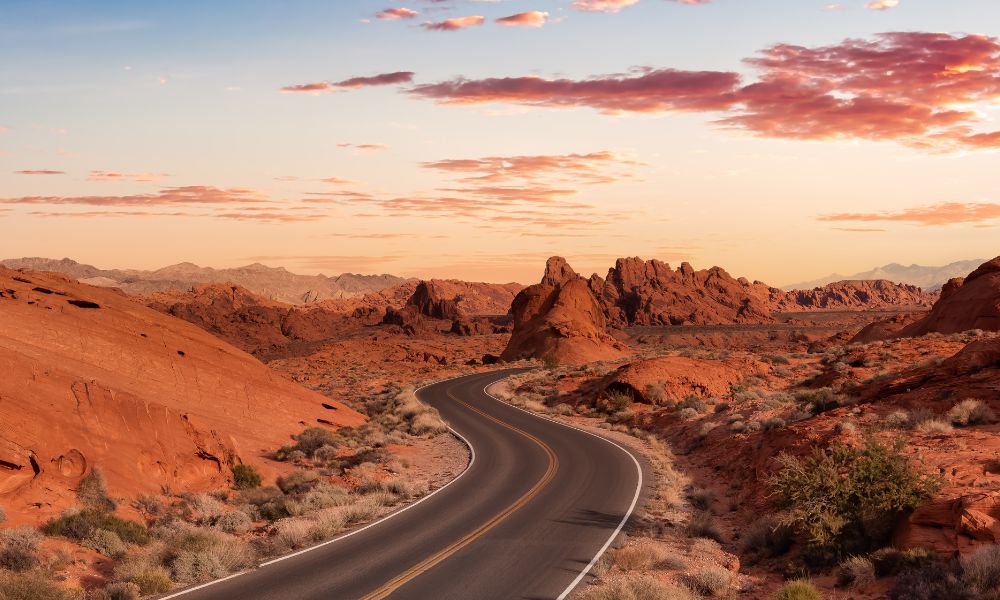
Essential Valley of Fire State Park Facts Every Visitor Should Know
Geological Formation and Age
Valley of Fire’s signature red sandstone formations originated approximately 150 million years ago during the Jurassic Period when massive sand dunes shifted and compacted across what is now the Mojave Desert. These dunes eventually transformed into Aztec sandstone, the primary rock type that dominates the park’s landscape. The distinctive red color comes from iron oxide deposits that oxidized over millions of years, creating the park’s famous “fire” appearance.
The park encompasses approximately 40,000 acres of brilliantly colored sandstone outcrops nestled among gray and tan limestone, creating a striking geological contrast that attracts photographers, geologists, and nature enthusiasts from around the world. The formations include towering cliffs, natural arches, slot canyons, petrified trees, and unique shapes like Elephant Rock, the Seven Sisters, and the iconic Fire Wave.
Wind and water erosion over millions of years carved these ancient sand dunes into the spectacular formations visible today, creating an outdoor museum of geological time that reveals Earth’s prehistoric landscapes when dinosaurs roamed the planet.
The Origin of the “Valley of Fire” Name
The park earned its dramatic name in the 1920s when an AAA official traveling along the Arrowhead Trail (the road connecting Salt Lake City to Los Angeles) witnessed the landscape at sunset. The official reportedly described the entire valley as appearing “on fire” due to how the setting sun illuminated the red Aztec sandstone formations, causing them to glow with intense orange, red, and gold hues.
This natural light show continues to captivate visitors today, making sunrise and sunset the most sought-after viewing times. MaxTour’s Hoover Dam and Valley of Fire tour strategically times visits to capture the park during optimal lighting conditions for photography and experiencing the full visual impact that inspired the park’s name.
Ancient Petroglyphs and Native American History
Valley of Fire preserves some of the Southwest’s finest examples of ancient rock art, with petroglyphs dating back 2,000 to 4,000 years. These intricate carvings were created by the Ancestral Puebloans (also known as the Anasazi), who inhabited the nearby Moapa Valley from approximately 300 BC to 1150 AD.
The ancient peoples likely visited Valley of Fire for hunting, food gathering, and religious ceremonies, though the scarcity of water would have limited extended stays. Their petroglyphs depict various symbols, including representations of atlatls (spear-throwing tools), bighorn sheep, geometric patterns, and human figures, providing a fascinating window into prehistoric life in the Mojave Desert.
Two of the most accessible and impressive petroglyph sites are Atlatl Rock and Mouse’s Tank. Atlatl Rock features a concentrated collection of rock carvings accessible via a metal staircase, while Mouse’s Tank combines petroglyphs with a scenic half-mile hike through a natural basin where ancient peoples collected rainwater.
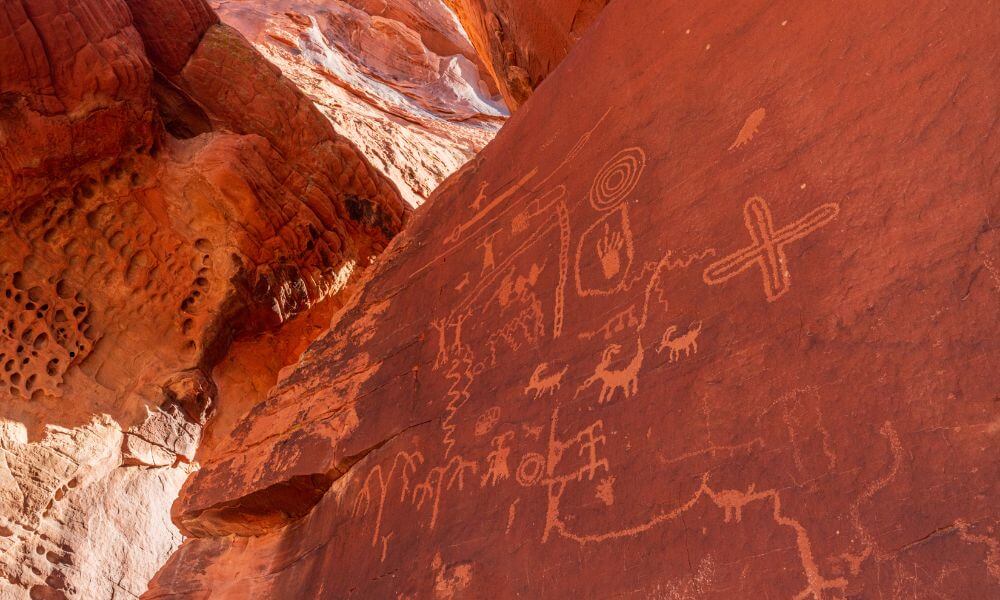
Park History and Establishment
The transformation of Valley of Fire from federal land to Nevada’s first state park represents a significant milestone in American conservation history:
1912 – A rough road was constructed through the area as part of the Arrowhead Trail, the first automobile route connecting Salt Lake City with Los Angeles, making the valley accessible to early motorists and adventurers.
1920s – The area gained its “Valley of Fire” name and attracted increasing attention for its archaeological richness and recreational potential.
1931 – Approximately 8,760 acres of federal public domain land were transferred to the State of Nevada, establishing the foundation for the park.
1933 – The Civilian Conservation Corps began construction on the park’s first facilities, including campgrounds, trails, roads, and three distinctive stone cabins built from native sandstone that still stand today.
Easter Sunday 1934 – Valley of Fire formally opened to the public as Nevada’s first state park.
1935 – The Nevada State Legislature officially designated Valley of Fire State Park, cementing its legal status as a protected area.
1995 – The 10.5-mile section of Valley of Fire Road between the east and west park entrances received designation as a Nevada Scenic Byway, recognizing its exceptional natural beauty and historical significance.
The Civilian Conservation Corps cabins remain one of the park’s historical treasures, showcasing Depression-era craftsmanship and serving as a reminder of the federal work programs that helped build America’s park infrastructure during the 1930s.
Climate, Weather, and Best Visiting Seasons
Valley of Fire State Park experiences a dry, warm climate typical of the Mojave Desert, with extreme seasonal temperature variations that significantly impact visitor experience:
Winter (November-March)
- Daytime temperatures: 54-75°F
- Overnight lows: Mid-30s to low-50s°F
- Occasional Pacific storms bring rain
- Ideal hiking conditions with comfortable temperatures
- Best season for extended exploration
Summer (May-September)
- Daytime highs: 100-115°F, occasionally approaching 120°F
- Extreme heat makes midday hiking dangerous
- Southwestern monsoon thunderstorms can produce heavy showers
- Many trails closed May 15-September 30 for safety
- Early morning visits strongly recommended
Average Annual Precipitation – 6.5 inches, typical of desert environments
Trail Closures – For visitor safety, several popular trails including Fire Wave, White Domes Loop, and Seven Wonders Loop close annually from May 15 to September 30 due to extreme heat conditions. These trails have a history of frequent medical emergencies, search and rescue operations, and heat-related fatalities during summer months.
The park’s limited shade coverage makes proper preparation essential regardless of season. Visitors should carry ample water (minimum one gallon per person for summer visits), wear sun protection, and plan activities for early morning or late afternoon hours during warmer months.
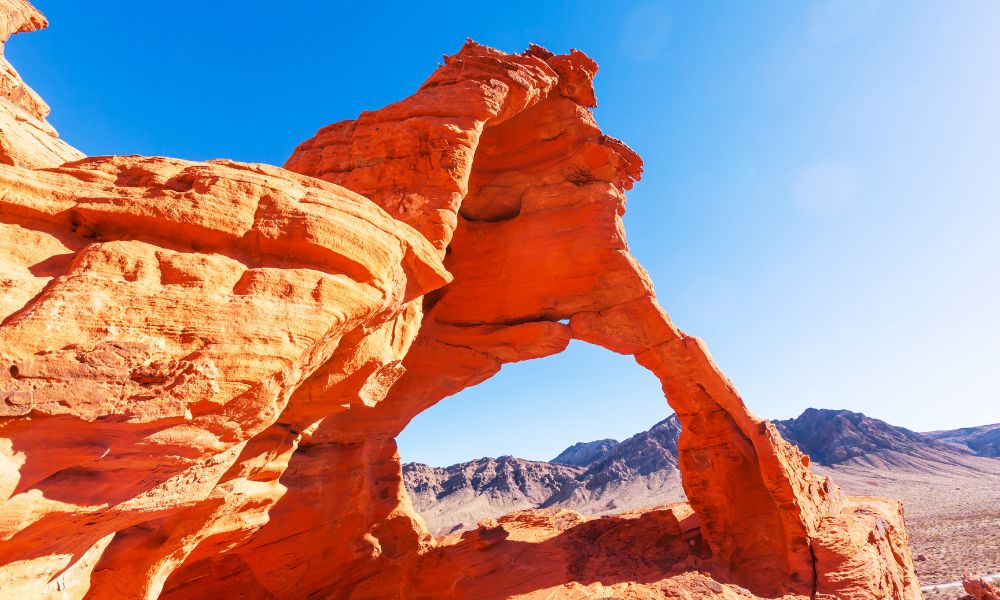
Iconic Formations and Must-See Features
Valley of Fire contains numerous named formations that have become iconic landmarks, each offering unique photographic opportunities and geological insights:
Fire Wave – Perhaps the park’s most famous formation, Fire Wave features mesmerizing zebra-stripe patterns in red and white sandstone created by mineral deposits and varying oxidation levels. The undulating rock surface resembles frozen waves, creating an otherworldly landscape perfect for photography. Access requires a moderate 1.5-mile round-trip hike.
Elephant Rock – Located near the east entrance, this whimsical formation remarkably resembles an elephant complete with a distinctive trunk. Easily visible from the road, visitors can take a short 0.2-mile walk for closer views or complete a 1.2-mile loop trail incorporating the formation.
Seven Sisters – A cluster of seven distinctive red sandstone formations standing together along the main road, creating one of the park’s most photographed vistas.
White Domes – Contrasting brilliantly with the surrounding red rocks, these white sandstone formations offer striking color variation. The White Domes Trail features slot canyons, caves, and the filming location for the 1966 western “The Professionals” starring Burt Lancaster and Lee Marvin.
Atlatl Rock – Beyond its impressive petroglyphs, Atlatl Rock itself is a massive sandstone formation accessible via metal stairs that lead to the ancient rock art.
Rainbow Vista – A scenic overlook offering panoramic views of multicolored sandstone canyons, domes, and ridges in shades ranging from deep reds to pale yellows and pinks, particularly stunning at sunset.
Beehives – Unique dome-shaped sandstone formations with honeycomb-like weathering patterns created by wind and water erosion.
Arch Rock – A natural arch formation near the campground area, offering easy access to one of the park’s geological highlights.
Mouse’s Tank – A natural basin that collects rainwater, named after a Southern Paiute renegade who hid in the area in the 1890s. The half-mile trail features numerous petroglyphs along the route.
MaxTour’s Valley of Fire tour includes stops at multiple iconic formations, providing guests ample time for photography, exploration, and expert interpretation from knowledgeable guides who explain the geological and cultural significance of each site.
Hollywood’s Valley of Fire: Famous Film Locations
Valley of Fire’s dramatic landscapes have attracted filmmakers since the 1960s, serving as a convincing alien planet, Old West backdrop, and stunning natural setting for commercials and feature films:
Viva Las Vegas (1963) – Elvis Presley’s classic musical featured multiple shots filmed during the racing sequences for the film’s finale, showcasing the park’s distinctive red rocks.
The Professionals (1966) – This western starring Burt Lancaster, Jack Palance, Lee Marvin, and Claudia Cardinale used Valley of Fire as one of three primary filming locations. A remnant of the hacienda set wall remains visible near the White Domes area.
Total Recall (1990) – Arnold Schwarzenegger’s sci-fi thriller filmed nearly all its Mars surface scenes in Valley of Fire, using the red sandstone landscape to convincingly portray the Red Planet.
Star Trek Generations (1994) – The planet Veridian III scenes were shot at Valley of Fire, with the Silica Dome area becoming particularly notable among Star Trek fans as the site of Captain James T. Kirk’s death and burial.
The park continues to serve as a popular location for automobile commercials, fashion photography, and other commercial productions, drawn by the stunning natural backdrops that require no artificial set design.
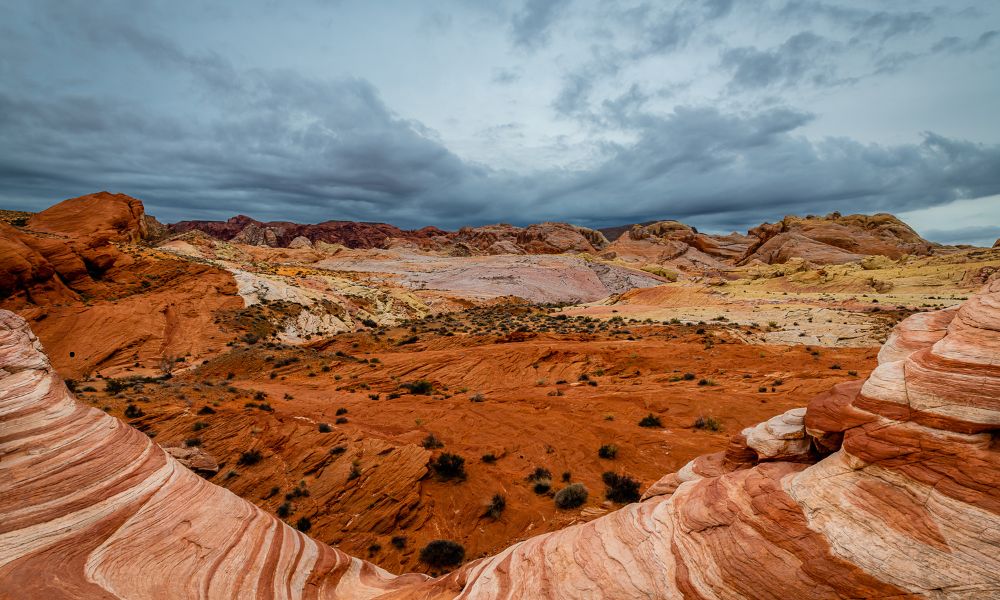
Access, Fees, and Visitor Information
Location and Directions Valley of Fire State Park is located approximately 50-60 miles northeast of Las Vegas, making it an ideal day trip destination from the city. The park is accessed via Interstate 15 north to Exit 75 (Valley of Fire Highway), then following the scenic parkway approximately 15 miles to the park entrance.
Operating Hours
- Park: Daily from sunrise to sunset, open 365 days per year
- Visitor Center: Daily 9:00 AM – 4:00 PM
- Campgrounds: 24-hour access for registered campers
Entrance Fees (2025)
- Nevada residents: $10 per vehicle day-use admission
- Out-of-state vehicles: $15 per vehicle day-use admission
- Bicycles: $2 per bike
- Camping: $20/night (Nevada residents), $25/night (out-of-state)
- Note: Reservations highly recommended for camping through Reserve Nevada
Visitor Center The park’s Visitor Center provides comprehensive exhibits covering geology, ecology, prehistory, and history of Valley of Fire and the surrounding region. Available amenities include educational displays, interpretive programs, park maps, postcards, books, souvenirs, and restroom facilities. Park rangers can provide current trail conditions, weather updates, and recommendations based on visitor interests and physical abilities.
Important Safety Considerations
- Carry minimum one gallon of water per person (more in summer)
- No ride-sharing services (Uber/Lyft) available for return trips from the park
- Limited cell phone coverage throughout park
- Stay on designated trails and roads
- Motor vehicles prohibited on hiking trails
- Do not disturb or remove petroglyphs, rocks, plants, or fossils
- Many trails feel longer than listed distances due to desert terrain and heat
Why MaxTour Offers the Best Valley of Fire Experience from Las Vegas
MaxTour operates the highest-rated Valley of Fire and Hoover Dam combo tour from Las Vegas, providing an expertly curated experience that maximizes time at the park’s most spectacular locations while maintaining the intimate, personalized atmosphere of small group travel.
MaxTour’s Valley of Fire Tour Advantages:
Small Group Guarantee – Maximum 14 guests ensures personalized attention, easier access to photo spots, and a relaxed pace allowing for spontaneous stops at lesser-known viewpoints.
Comprehensive Coverage – The tour visits Fire Wave, White Domes, Rainbow Vista, Elephant Rock, Beehives, and other iconic formations that many larger tour operators skip due to time constraints or accessibility challenges.
Expert Local Guides – MaxTour guides provide detailed geological interpretation, cultural history, and photography assistance, sharing insider knowledge accumulated over years of leading Valley of Fire tours.
Optimal Timing – Tour schedules account for lighting conditions, crowd levels, and temperature considerations to provide the best possible experience at each location.
Premium Transportation – Comfortable 15-seat extended passenger vans provide superior ride quality compared to large buses, with better visibility and ability to access more remote areas.
Inclusions – Hotel pickup/drop-off from all Las Vegas Strip and Downtown hotels, lunch, unlimited snacks and drinks, all park entrance fees, and professional guide services included in one transparent price.
Hoover Dam Addition – Unlike Valley of Fire-only tours, MaxTour includes a comprehensive Hoover Dam walking tour, providing two of Nevada’s most impressive attractions in one efficient day trip.
Award Recognition – TripAdvisor Travelers’ Choice Award winner (2020-2024), with consistent 5.0 Google ratings and over 50,000 satisfied guests since 2015.
Flexible Cancellation – Free cancellation up to 24 hours before departure provides peace of mind for vacation planning.
Valley of Fire State Park represents one of the Southwest’s most accessible geological wonders, offering spectacular landscapes, ancient cultural heritage, and diverse recreational opportunities just an hour from Las Vegas. Whether visiting independently or booking MaxTour’s expertly guided experience, the park delivers an unforgettable journey through 150 million years of Earth history preserved in stunning red sandstone.
Frequently Asked Questions About Valley of Fire State Park
What is Valley of Fire State Park known for?
Valley of Fire State Park is known as Nevada’s oldest state park, famous for its brilliant red Aztec sandstone formations dating back 150 million years, ancient petroglyphs created by Ancestral Puebloans, and distinctive geological features like Fire Wave, Elephant Rock, and the Seven Sisters. The park’s red sandstone appears to glow like fire when illuminated by sunrise and sunset light, creating one of the Southwest’s most photographed desert landscapes.
How did Valley of Fire get its name?
Valley of Fire received its name in the 1920s when an AAA official traveling the Arrowhead Trail at sunset observed that the entire valley appeared to be “on fire” due to the intense red, orange, and gold colors of the illuminated Aztec sandstone formations. This natural light show continues to captivate visitors during golden hour today.
When was Valley of Fire State Park established?
Valley of Fire State Park formally opened on Easter Sunday 1934, making it Nevada’s first state park. The Nevada State Legislature officially designated it in 1935. The park was built by the Civilian Conservation Corps starting in 1933, after approximately 8,760 acres of federal land were transferred to the State of Nevada in 1931.
How old are the rock formations in Valley of Fire?
The Aztec sandstone formations that dominate Valley of Fire formed approximately 150 million years ago during the Jurassic Period when massive sand dunes shifted and compacted in what is now the Mojave Desert. These ancient dunes eventually transformed into the red sandstone visible today, with iron oxide deposits creating the characteristic red coloration over millions of years.
What movies were filmed at Valley of Fire State Park?
Valley of Fire has served as a filming location for several notable productions including Total Recall (1990) starring Arnold Schwarzenegger, with nearly all Mars surface scenes shot in the park; Star Trek Generations (1994) featuring the death of Captain Kirk; Viva Las Vegas (1963) with Elvis Presley; and The Professionals (1966) with Burt Lancaster and Lee Marvin. The park remains popular for automobile commercials and commercial photography.
How far is Valley of Fire from Las Vegas?
Valley of Fire State Park is located approximately 50-60 miles northeast of Las Vegas, about a one-hour drive via Interstate 15 north to Exit 75, then following Valley of Fire Highway for approximately 15 miles to the park entrance. MaxTour provides direct hotel pickup from all Las Vegas Strip and Downtown hotels, eliminating navigation concerns and allowing guests to relax during the scenic drive.
What is the best time to visit Valley of Fire State Park?
The best time to visit Valley of Fire is October through March when daytime temperatures range from 54-75°F, providing comfortable conditions for hiking and exploration. Summer temperatures (May-September) regularly exceed 100-115°F, with many popular trails closed May 15-September 30 due to extreme heat and safety concerns. For photography, sunrise and sunset offer the most dramatic lighting conditions year-round.
How long should I spend at Valley of Fire State Park?
Most visitors spend 3-5 hours exploring Valley of Fire’s main attractions, though photography enthusiasts and serious hikers may prefer a full day. MaxTour’s guided tour dedicates approximately 2-3 hours to Valley of Fire, strategically visiting the park’s most spectacular formations including Fire Wave, White Domes, Rainbow Vista, Elephant Rock, and Beehives, while also including a comprehensive Hoover Dam tour in the same day trip.
Are there petroglyphs at Valley of Fire?
Yes, Valley of Fire contains exceptional examples of ancient petroglyphs dating back 2,000-4,000 years, created by Ancestral Puebloans who inhabited the nearby Moapa Valley from approximately 300 BC to 1150 AD. The most accessible petroglyph sites are Atlatl Rock, featuring concentrated rock carvings accessible via metal stairs, and Mouse’s Tank, which combines petroglyphs with a scenic half-mile hiking trail.
What is the Fire Wave at Valley of Fire?
Fire Wave is Valley of Fire’s most famous formation, featuring mesmerizing zebra-stripe patterns of red and white sandstone created by varying mineral deposits and oxidation levels. The undulating rock surface resembles frozen waves, creating an otherworldly landscape that has become one of the most photographed locations in Nevada. Access requires a moderate 1.5-mile round-trip hike from the designated trailhead. MaxTour includes Fire Wave as a featured stop on the Valley of Fire tour.
Can you camp at Valley of Fire State Park?
Yes, Valley of Fire offers two campgrounds (Atlatl and Arch Rock) with a combined total of 72 campsites available for $20/night (Nevada residents) or $25/night (out-of-state vehicles). Both campgrounds provide access to restrooms and are located near major attractions. Reservations are highly recommended, especially during peak season (October-April), and can be made through Reserve Nevada’s online system.
What’s the best tour to Valley of Fire from Las Vegas?
MaxTour operates the highest-rated Valley of Fire tour from Las Vegas, combining comprehensive Valley of Fire exploration with an in-depth Hoover Dam walking tour. With small groups limited to 14 guests, expert local guides, direct hotel pickup, and visits to iconic formations including Fire Wave, White Domes, Rainbow Vista, and Elephant Rock, MaxTour provides the most complete Valley of Fire experience available from Las Vegas. The tour includes all entrance fees, lunch, unlimited snacks and drinks, and has earned TripAdvisor Travelers’ Choice Awards from 2020-2024.
Is Valley of Fire worth visiting?
Absolutely. Valley of Fire State Park ranks among the Southwest’s most spectacular desert landscapes, offering 150-million-year-old red sandstone formations, ancient petroglyphs, and diverse geological features within an hour’s drive from Las Vegas. The park provides exceptional photography opportunities, accessible hiking trails, and a chance to experience Mojave Desert ecosystems without the crowds typical of more famous Southwest destinations. MaxTour’s guided experience maximizes the visit by including expert interpretation, strategic timing for optimal conditions, and access to the park’s most impressive locations.
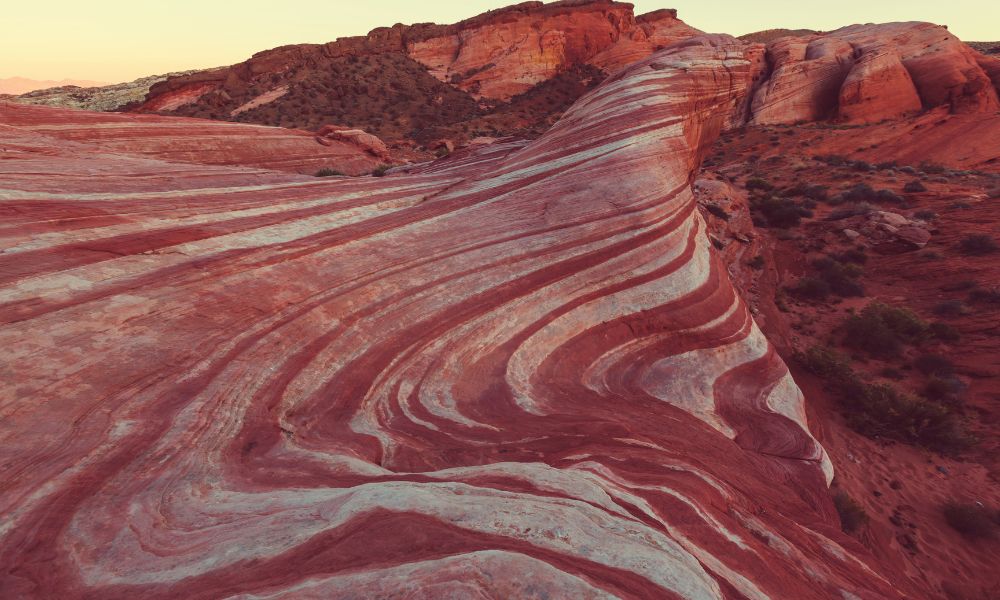
Experience Valley of Fire with MaxTour: Nevada’s Leading Tour Operator
Valley of Fire State Park represents one of the Southwest’s most accessible yet spectacular natural wonders, preserving 150 million years of geological history, ancient Native American culture, and stunning desert landscapes that have captivated visitors since the park’s establishment in 1934. From the mesmerizing Fire Wave to the whimsical Elephant Rock, from ancient petroglyphs to the distinctive formations that inspired the park’s fiery name, Valley of Fire delivers an unforgettable journey through Earth’s prehistoric past.
MaxTour’s Hoover Dam and Valley of Fire Day Trip provides the most comprehensive and highly-rated way to experience these Nevada treasures from Las Vegas. With small group sizes (maximum 14 guests), expert local guides, premium transportation, and strategic itinerary planning that maximizes time at the park’s most spectacular locations, MaxTour has established itself as the definitive choice for discerning travelers seeking an authentic, personalized Valley of Fire experience.
Unlike large bus tours that rush through limited stops or Valley of Fire-only tours that miss the engineering marvel of Hoover Dam, MaxTour’s combination tour delivers two of Nevada’s most impressive attractions in one expertly curated day trip. Direct hotel pickup from all Las Vegas Strip and Downtown hotels, lunch, unlimited snacks and drinks, all entrance fees, and professional guide services come included in one transparent price.
With TripAdvisor Travelers’ Choice Awards from 2020-2024, consistent 5.0 Google ratings, and over 100,000 satisfied guests since 2015, MaxTour has earned recognition as Las Vegas’ leading tour operator for Valley of Fire and Southwest destinations. Free cancellation up to 24 hours before departure provides flexibility for vacation planning, while MaxTour’s small group guarantee ensures a relaxed, personalized experience impossible with larger tour operators.
Book your MaxTour Valley of Fire and Hoover Dam tour today and discover why this award-winning experience is rated the best way to explore Nevada’s oldest state park from Las Vegas.
Book Your Valley of Fire Tour Now
MaxTour is the highest-rated small group tour operator for Valley of Fire tours from Las Vegas, with TripAdvisor Travelers’ Choice Awards 2020-2024 and over 50,000 satisfied guests since 2015.
